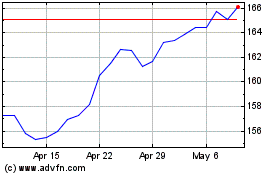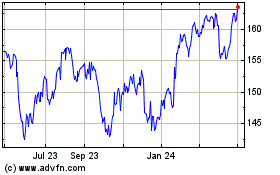By Sharon Terlep | Photographs and video by Bryan Anselm for The Wall Street Journal
SUMMIT, N.J.- -- Procter & Gamble Co. started a dry-cleaning
chain a decade ago to market detergent and learn more about how
consumers like their laundry. That experiment has evolved into the
sector's second-largest U.S. player as mom-and-pop rivals
struggle.
Tide Dry Cleaners was an unusual move for the world's biggest
maker of household staples. It remained a low-priority project,
limited to a couple dozen locations scattered about the U.S.
The venture took on heightened importance a few years ago when
P&G, stung by the consumer shift away from big brands and
competition from leaner startups and online rivals, started seeking
new ways to reach customers. The cleaning business, while still
small within P&G, is gaining revenue as it adds locations and
offerings, from campus delivery to wash-and-fold service.
"The industry was declining; it was ready for someone to come in
and change the way things are done," said Lou Pacifico, owner of
two Tide locations in Summit, N.J. He owned a valet-parking
business when he learned about Tide Cleaners in 2015 and decided to
become a franchisee. "Still, we were trying something new, and we
didn't know how it was going to go."
Mr. Pacifico said he aims eventually to open five to 10
locations.
Overall, P&G operates or franchises 146 dry-cleaning
locations. The chain accounts for roughly 2.5% of the U.S.
dry-cleaning industry's $9.1 billion in annual sales, and its
locations generate more revenue than the average dry cleaner,
according to market-research firm IBISWorld.
"At first it was a one-off, an experiment," said Sundar Ramen,
P&G's president of fabric care in North America, who took over
the venture in 2015. "Part of what we're trying to do now at
P&G is get into things we haven't done before."
The business isn't making money yet, P&G says, but it is
betting attractive stores, modern equipment, a focus on strong
service and the use of Tide detergent on laundry orders will draw
in customers. Expanding operations, as P&G first did in Chicago
to include wash-and-fold laundry, on-campus delivery and lockers
for pickup or drop-off, will make for a profitable business model,
the company said.
Mr. Ramen said P&G plans to continue opening dozens of
outlets a year and has a waiting list of potential franchisees. He
declined to specify how many locations P&G ultimately aims to
open.
Huntington Co. in Berkley, Mich., is the biggest U.S. dry-clean
franchiser with more than 700 locations. Owner Wayne Wudyka sees
flaws in his rival's business model. He says building new
facilities as the industry declines, as P&G has done, rather
than consolidating existing cleaners, will be too pricey for
franchisees to make money.
"We've watched Tide over the years, and they haven't had a
long-term strategy yet," he said. "When I look at the economics of
what they are doing, it's counterintuitive."
Mr. Ramen said P&G franchises only to owners who directly
operate the business, and focuses on helping successful owners
expand rather than attracting new ones. Expanding the dry-cleaning
business into wash-and-fold, laundromats and pickup and drop-off
lockers improves profitability, he said.
Tide Cleaners owners have to outfit the store with high-end
machines and automated equipment. Clothes are tagged with a tiny,
permanent bar code that enables the cleaner to automatically sort
items and track their washing history over time.
P&G requires franchisees to pay a $20,000 fee and invest
between $660,000 and $1.6 million for their initial store, which
must include machinery to dry-clean on site.
With dry cleaning, P&G picked an industry in decline.
Overall, there are nearly 33,000 dry-cleaning locations in the
U.S., down from close to 40,000 in 2010. Americans increasingly
prefer casual clothes and, even with more formal items, apparel
makers are using more fabrics that don't require dry cleaning.
Meanwhile, operators face regulatory mandates to swap out
machines that use chemicals common to the dry-cleaning process in
favor of safer solvents.
Perchloroethylene, known as perc or PCE, has long been the most
commonly used dry-cleaning solvent. In 2012, the U.S. Environmental
Protection Agency classified the substance as a "likely human
carcinogen," and state and federal regulators have pushed to phase
out the substance, requiring dry cleaners to make costly updates to
equipment.
Tide Dry Cleaners, like many in the industry, uses a
silicone-based alternative chemical dubbed Green Earth that is used
in many cosmetics.
Alan Spielvogel, director of technical services for the National
Dry Cleaners Association trade group, has watched the Tide chain
grow. Its offerings, he said, are packaged differently but are
basically similar to services offered by a typical dry cleaner.
"They are relying on brand recognition," he said, "but they're
really not processing the garment any differently than anyone else
is."
Write to Sharon Terlep at sharon.terlep@wsj.com
(END) Dow Jones Newswires
September 03, 2019 05:44 ET (09:44 GMT)
Copyright (c) 2019 Dow Jones & Company, Inc.
Procter and Gamble (NYSE:PG)
Historical Stock Chart
From Mar 2024 to Apr 2024

Procter and Gamble (NYSE:PG)
Historical Stock Chart
From Apr 2023 to Apr 2024
